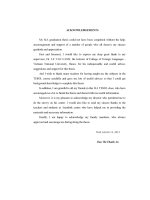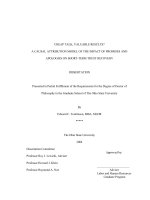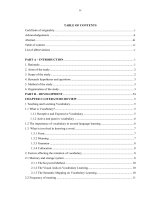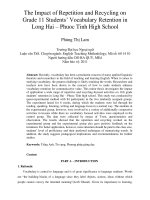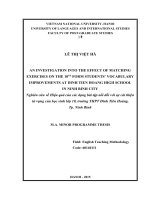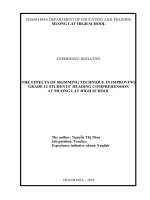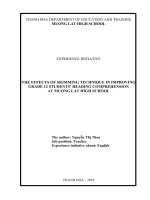The Impact of repetition and recycling on grade 11 students' vocabulary retention at Long Hai-Phuoc Tinh High school = Tác động của việc luyện tập củng cố đối v.PDF
Bạn đang xem bản rút gọn của tài liệu. Xem và tải ngay bản đầy đủ của tài liệu tại đây (616.62 KB, 18 trang )
VIETNAM NATIONAL UNIVERSITY, HANOI
UNIVERSITY OF LANGUAGES AND INTERNATIONAL STUDIES
FACULTY OF POST- GRADUATE STUDIES
****************************************
PHÙNG THỊ LAM
THE IMPACT OF REPETITION AND RECYCLING ON
GRADE 11 STUDENTS’ VOCABULARY RETENTION
IN LONG HAI – PHUOC TINH HIGH SCHOOL
(TÁC ĐỘNG CỦA VIỆC LUYỆN TẬP CỦNG CỐ
ĐỐI VỚI SỰ GHI NHỚ TỪ VỰNG CỦA HỌC SINH LỚP 11
Ở TRƯỜNG THPT LONG HẢI – PHƯỚC TỈNH )
MINOR M.A THESIS
Field: English Teaching Methodology
Code: 60 14 10
HÀ NỘI, 2011
VIETNAM NATIONAL UNIVERSITY, HANOI
UNIVERSITY OF LANGUAGES AND INTERNATIONAL STUDIES
FACULTY OF POST- GRADUATE STUDIES
****************************************
PHÙNG THỊ LAM
THE IMPACT OF REPETITION AND RECYCLING ON
GRADE 11 STUDENTS’ VOCABULARY RETENTION
IN LONG HAI – PHUOC TINH HIGH SCHOOL
(TÁC ĐỘNG CỦA VIỆC LUYỆN TẬP CỦNG CỐ
ĐỐI VỚI SỰ GHI NHỚ TỪ VỰNG CỦA HỌC SINH LỚP 11
Ở TRƯỜNG THPT LONG HẢI – PHƯỚC TỈNH )
MINOR M.A THESIS
Field: English Teaching Methodology
Code: 60 14 10
Supervisor: ĐỖ BÁ QUÝ, M.A
HÀ NỘI, 2011
iv
TABLE OF CONTENTS
Certificate of originality……………..………………………………………………………i
Acknowledgements ……...…………………………………………………………………ii
Abstract……………………………………...……………………………………………..iii
Table of content ……………………………………………………………………………iv
List of abbreviations ………………………………………………………………………..v
PART A – INTRODUCTION ............................................................................................. 1
1. Rationale ............................................................................................................................ 1
2. Aims of the study ............................................................................................................... 2
3. Scope of the study .............................................................................................................. 2
4. Research hypotheses and questions ................................................................................... 3
5. Method of the study ........................................................................................................... 3
6. Organization of the study ................................................................................................... 3
PART B – DEVELOPMENT............................................................................................ 54
CHAPTER I: LITERATURE REVIEW ........................................................................... 5
1 Teaching and Learning Vocabulary .................................................................................... 5
1.1 What is Vocabulary? ........................................................................................................ 5
1.1.1 Receptive and Expressive Vocabulary .................................................................. 5
1.1.2 Active and passive vocabulary .............................................................................. 6
1.2 The importance of vocabulary in second language learning ........................................... 6
1.3 What is involved in knowing a word .............................................................................. 7
1.3.1 Form ...................................................................................................................... 7
1.3.2 Meaning ................................................................................................................ 7
1.3.3 Grammar ............................................................................................................... 8
1.3.4 Collocation ............................................................................................................ 8
2. Factors affecting the retention of vocabulary. ................................................................... 8
2.1 Memory and storage system ............................................................................................ 8
2.1.1 The Keyword Method ......................................................................................... 10
2.1.2 The Visual Aids on Vocabulary Learning .......................................................... 10
2.1.3 The Semantic Mapping on Vocabulary Learning ............................................... 10
2.2 Frequency of meeting .................................................................................................... 11
v
2.3 Quality of Processing ..................................................................................................... 11
3. Other factors .................................................................................................................... 11
3.1 Learning styles ........................................................................................................ 11
3.2 Teaching method...................................................................................................... 12
4. Repetition and Recycling in Language learning ............................................................. 12
4.1. The spacing of repetition ........................................................................................ 13
4.2. Testing and the Retrieval Practice Effect ............................................................... 14
5. A review of similar studies ............................................................................................. 14
CHAPTER 2 – METHODOLOGY…………………………………………………….15
1.The setting of study........................................................................................................... 16
1.1. Context of Study ...................................................................................................... 16
1.2. Why quasi – experimental research ......................................................................... 17
2. Participants of the study ................................................................................................... 18
2.1 Participants .............................................................................................................. 18
2.2 Sampling ................................................................................................................... 18
3. Materials .......................................................................................................................... 19
3.1 The course book ....................................................................................................... 19
3.2 The course content ..................................................................................................... 19
3.3 What are relevant activities? ...................................................................................... 19
4. Data collection instruments .............................................................................................................. 21
4.1 T –Test ...................................................................................................................... 21
4.1.1 The purpose of the test .......................................................................................... 21
4.1.2.What to test ........................................................................................................... 22
4.1.3. Test....................................................................................................................... 22
4.2. Questionnaires ............................................................................................................ 22
4.2.1.Questionnaires for students .................................................................................... 22
4.2.1.1.The pre-treatment questionnaire ....................................................................... 23
4.2.1.2.The post-treatment questionnaire...................................................................... 23
4.2.2.Questionnaires for teachers ..................................................................................... 23
5. Procedure of data collection ............................................................................................ 23
5.1. Schedules ...................................................................................................................... 24
5.2. Treatment ...................................................................................................................... 24
vi
5.3. Data collecting and processing procedures ................................................................... 25
CHAPTER 3 - DATA ANALYSIS AND FINDINGS ..................................................... 26
3.1 Results of the T – Test ................................................................................................... 26
3.2 The result of pre-test scores of the two groups .............................................................. 26
3.3. The result of post-test scores of the two groups ........................................................... 28
3.4 Summary of the test scores of the two groups in the pretest and posttest ..................... 32
3.5 Survey results ................................................................................................................ 33
3.5.1. The pre-treatment questionnaire for students ......................................................... 33
3.5.2. The Post-treatment Questionnaire for students ....................................................... 34
3.5.2. Questionnaire for teachers ...................................................................................... 34
PART C. CONCLUSION................................................................................................. 38
1. Findings and conclusion .................................................................................................. 38
2. Pedagogical Implications ................................................................................................. 40
3. Limitations of the study ................................................................................................... 41
4. Suggestions for further studies ........................................................................................ 41
REFERENCES…………………………………………………………………………..42
APPENDIX………………………………………………………………………………..I
1
PART A – INTRODUCTION
1. Rationale
Given its importance to learning, vocabulary has been a prominent concern of many
theorists and researchers in the field.
In learning English, however, the greatest challenge is likely retaining the words.
Researchers and teachers now have been drawn to the concern of how to make students
enhance vocabulary retention for communicative value. Studies have shown that practising
things makes us better in learning a language and develops automaticity. In other words,
language learning proceeds gradually through repeated exposure and practice. The course
book English 11 (published by Educational Press), however, does not deal with it sufficiently.
Many students now suffer from considerable difficulties in retaining previously
encountered English words. They struggle to maintain retention. But not many of them are
capable of it. This matter of fact leads to their poor production both in speaking and writing.
2. Aims of the study
The aim of this study is to investigate the impact of repetition and recycling on vocabulary
learning and retention, or to put it differently, the extent to which short tailored activities helps
to retain vocabulary for the students at Long Hai – Phuoc Tinh High school and some
pedagogical implications.
3. Scope of the study
In the current study, the author set the limit of investigating possibly – applied activities
that can be carried out at beginning or in the middle of 45-minute periods in such large-sized
classes at Long Hai – Phuoc Tinh High school, vung Tau. The activities were related to first
three units (which equal to 18 lessons) of the course book English 11.
4. Research hypotheses and questions
The study is to get the answers to the following questions:
1) To what extent do EFL teachers encourage repetition and recycling vocabulary among
their students?
2) What is the effectiveness of using repetitive and recycling focused activities on enhancing
11th - graders’ vocabulary retention?
2
3) What are the students’ attitudes towards using activities in teaching and learning
vocabulary?
5. Method of the study
The study is a quasi-experimental design involving the three components of experiments:
the population (the 11th grade students at Long Hai – Phuoc Tinh high school, Ba Ria Vung
Tau), the treatment (repetitive and recycling focused activities), and the measurement of the
treatment (T-test).
- Questionnaires were delivered to teachers to investigate the ways they encourage repetition
and recycling vocabulary among students.
- Questionnaires were delivered to the subjects before treatment to get to know their own
strategies of memorizing vocabulary.
- Questionnaire s were delivered to the subjects after treatment as a supporting tool to obtain
their attitude towards the technique applied.
- Observation was also employed during the teaching time to recognize the participation of
students in the control group and the experimental group.
6. Organization of the study
This thesis is organized around three parts:
Part A is the introduction which presents the rationale for the research topic, aims of study,
scope of study, research hypotheses and questions, and method of the study.
Part B is the development which consists of three chapters.
- Chapter one reviews scholarly theoretical background to teaching and learning vocabulary in
a second language.
- Chapter two deals with the methodology of this research in terms of the setting of the study,
sampling participants, instruments and procedure of data collection.
- Chapter three devotes to the account of the study in terms of data analysis and findings
interpreted from the results of the T-test and questionnaires.
Part C is the conclusion which discusses the major findings and limitations of the research,
then suggests teaching implications and proposes some suggestions for further research.
3
PART B - DEVELOPMENT
CHAPTER I: LITERATURE REVIEW
1 Teaching and Learning Vocabulary
1.1 What is Vocabulary?
1.1.1
Receptive and Expressive Vocabulary
1.1.2 Active and passive vocabulary
1.2 The importance of vocabulary in second language learning
1.3 What is involved in knowing a word
1.3.1 Form
1.3.2 Meaning
1.3.3 Grammar
1.3.4 Collocation
2. Factors affecting the retention of vocabulary.
2.1 Memory and storage system
2.1.1 The Keyword Method
2.1.2 The Visual Aids on Vocabulary Learning
2.1.3 The Semantic Mapping on Vocabulary Learning
2.2 Frequency of meeting
2.3 Quality of processing
3. Other factors
3. 1 Learning styles
3. 2 Teaching method
4. Repetition and Recycling in Language learning
4.1. The spacing of repetition
4.2. Testing and the Retrieval Practice Effect
5. A review of similar studies
CHAPTER 2 – METHODOLOGY
1.The setting of study
1.1 Context of Study
4
Long Hai – Phuoc Tinh high school is a state-run school located in Long Hai town in Ba
Ria – Vung Tau. The school has a modest educational staff of 71 people who provide
education to 1425 students. The EFL group consists of 9 teachers.
The typical setting of instruction is three 45-minute –long periods of English a week.
Due to the limited time in a correspondence to a wide range of words to teach and
students’ low English proficiency, EFL teachers at Long Hai _ Phuoc Tinh high school often teach
vocabulary in the traditional teacher-centered method. The teachers normally dominate class to explain
words by words. They often employ three following steps in teaching vocabulary. First, teachers have
students read the passage. After that, new words are raised and elicited through some games, word
maps, or simple presentations. Then students try to get Vietnamese equivalents of the words and read
them aloud once or twice. To help students practice the vocabulary, the teachers have them do some
kinds of exercises such as: gap filling, word matching, definitions matching, etc.. available in the
course book.
1.2 Why quasi – experimental research
As this study was conducted on the students in two already existing classes which were
assigned by the high school where the researcher was working, a quasi-experimental method
was naturally chosen.
1.
Participants of the study
2.1 Participants
The population of the study were 84 ESL students coming from two classes in Long HaiPhuoc Tinh high school in BR-VT. Most of them were born in 1995 and have studied English
as a Foreign Language for five years or more. Results of the pre-test showed that their English
vocabulary competence differed little. All in all, these two groups had a lot of common
features in terms of number, gender, English level as well as motivation to learn. Moreover,
these students’ characteristics were typical of the 11th grade non-major students at Long HaiPhuoc Tinh high school.
2.2 Sampling
In the study the researcher adopted the systematic sampling as a strategy to select subjects
from a population list in a systematic. Specifically, with the required number of 56 out of the
population of 84, the simple statistic should be use:
f=N÷ Sn
5
f = frequency interval
N = the total number of the wider population
Sn = the required number in the sample
Hence the frequency interval (f) is
84÷56 = 1.5
As a result, the researcher omitted every third name on the list of cases.
3.Materials
3.1 The course book
The English 11 is designed basing on the basic principles of Communicative Language
Teaching. However, the course book do not include sufficient communicative activities for
practice. This demands more work on the part of the teacher in selecting appropriate activities
to attract students.
3.2 The course content
As being stated above, due to the limitation of time and application, the study only deals
with three units among sixteen ones appearing in the current course book English 11, namely
unit 1 “Friendship”, unit 2 “Personal Experience”, and unit 3 “A Party”.
3.3 What are relevant activities?
- Activities that involve brief reading, repetition, making sentences, listing words and so on
are supposed to be relevant to provide background for practicing certain chunks or for
recycling vocabulary, thus aid language processing and ultimately vocabulary retention.
- When designing some extra activities, the researcher took into account all the conditions of
the participants and based on the Taxonomy of Vocabulary Learning Strategies which is
adopted from Schmitt 1997:207.
4. Data collection instruments
4.1 T -Test
The pre-test and post–test employed in the study were designed to measure the effect of
repetitive and recycling-focused activities on students’ ability to retain vocabulary.
4.1.1 The purpose of the test
- The pre-test was given to the two groups in the same week with the primary purpose of
measuring students’ vocabulary size and their level of vocabulary retention.
- The post-test was implemented to assess how effective the tailored activities utilized were. .
6
4.1.2 What to test
The pre-test served as a means to measure students’ vocabulary size and their level of
vocabulary retention. The target words in the pre-test were drawn from the word list of the
course book English 10 ( from unit 9 to unit 16 inclusively) whereas ones in the progress test
came from the glossary of three units of the course book and a number of words added by the
teacher on assumption of they are unfamiliar to the students.
4.1.3 Test
In the study, the test comprised five different types of exercises in the form of an
objective test. Here in this paper, the test frame included multiple choice, gap-filling, matching
and word – formation.
4.2 Questionnaires
4.2.1 Questionnaires for students
4.2.1.1 The pre-treatment questionnaire
On completing the study, 20 random subjects in the two groups were sampled out of the 56,
A questionnaire listed 15 memory strategies was used in the survey.
4.2.1.2 The post-treatment questionnaire
The post- treatment questionnaire was administered to get students’ feedback about the
treatment. It was a brief questionnaire with 5 questions.
4.2.2 Questionnaires for teachers
The aim of the questionnaire for teachers was to find out teachers' attitude towards
enhancing vocabulary retention and approaches they use. The questionnaire contains 10
questions where 3 questions require only yes and no responses.
5.
Procedure of data collection
The practice of study involves the systematic collection of information about the subjects,
activities, and outcomes of the experiment measuring the impact of repetition and recycling on
students’ vocabulary retention. This is a experimentally quantitative research involving a trial
in which the subjects (n=56) are measured before and after treatment with T-test.
5.1 Schedules
7
The study was carried out within 6 weeks of the first semester in 2 classes. Each class
work with English of 3 forty-five minute periods a week. So, the schedules were designed
upon 18 periods. The detailed schedule of supplemental activities for both class was in the
appendix 2.
5.2 Treatment
In the first stage, the participants were asked to take a vocabulary pretest. Then a brief
questionnaire is delivered.
In the class hours, both control and experimental group received the usual instruction and
exercises based on the course book. Words and structures were presented to them in a same
traditional manner. Regularly at the beginning of each class, the experimental group joined a
variety of activities designed by the teacher focusing on the production and recycling of the
words that they have learnt before. Six weeks later, students were unexpectedly given a posttest. The result of the test, then, was drawn out to be compared with the prior test. A follow-up
questionnaire was then administered to investigate students perceptions and attitudes toward
vocabulary learning.
5.3 Data collecting and processing procedures
The following steps were carried out to collect the results from the pretest and the posttest.
Step 1: Doing and marking the pre-test. All test - takers sat at the tests on the same day
under the serious control of the teacher (who is also the researcher). The pre-test took place on
16th August, 2011 and the marking process was seriously carried out right after the tests.
Step 2: Conducting a brief minor questionnaire to explore students’ preferred strategies to
memorize vocabulary.
Step 3: Doing and marking the post-test. The post-test took place on 24th September, 2011
and the marking process was seriously carried out right after the tests.
Step 4: Administering another questionnaire to investigate subjects’ attitude towards
techniques applied.
Step 5: Synthesizing the results of the pretest and posttest for later analysis and
comparisons.
Step 6: Using the SPSS software version 16.0 as a tool to analyze the results of the tests.
CHAPTER 3 - DATA ANALYSIS AND FINDINGS
8
3.1 Results of the T – Test
After having students do the pre-test and post-test, the researcher has devoted time to
seriously mark the tests. The scores were given on the 10- mark-scale.
3.2 The result of pre-test scores of the two groups
The result of pre-test showed that the participants of both groups almost have the equal
level of vocabulary competence. The mean of the control groups was 3.8 and mean of the
experimental group was 3.9. The slight difference of mean of 0.1 was not statistically
significant. Students in control group seemed to be of more uniform level whereas students
from experimental one had more excellent individuals. The means also showed that in general
the students were only at average level. And both two groups have no good students. They
were mainly at under the conventionally average score of 5 (75.1% students in control group
and 76,8% students in experimental group). In general, the English proficiency and vocabulary
size of students in both groups was at low level but rather equal. The correlation coefficient
(rxy) value of .743 means we can predict one test score from the second and that the error of
prediction is relatively small. Therefore, we would conclude that this test is reliable.
3.3 The result of post-test scores of the two groups
Comparing with the mean of the pretest, we can see that while the control group made a
little bit progress (from 3.8 to 5.2) the experimental one took big pace with a rise from 3.9 to
6.5. This big difference in the mean scores between pre-test and post-test showed very clearly
that after six weeks of enhancing repetition and recycling words in teaching and learning
vocabulary, the students’ vocabulary capacity has been improved significantly.
However, the change in SD of the two classes is different. The SD of 1.3 in pre-test and
1.5 in post test of the control group (students’ test scores varied a lot) showed that absorbing
vocabulary in the traditional approach depended on many other factors beyond teachingrelated ones. whereas steadily low standard deviation in the pre-test and post test scores of
experimental group indicates that the impact of repetition and recycling on students’
vocabulary was positive despite subjective factors.
Furthermore, the comparison between the pre-test and post-test scores of the experimental
group showed that the groups of low scores in the pre-test (ranged from 1.5 to 4) made more
progress than the group of high scores in the pre-test (ranged from 4.5 to 6.5) in term of scores
9
in the post-test. The low-scored group possessed the average additional score of 3.02 while the
high-scored only achieved 2.00 as the average additional score. This could lead to the
conclusion that the repetition and recycling work efficiently for weak students rather than
strong students.
The correlations between the pre-test and post-test scores in the two groups were rather
strong (r = .74 and .59 respectively). This implies that the implementation of method strategy
(using regular vocabulary – focused activities) might have succeeded in enhancing intrinsic
motivation of some participants and failed to do so to other participants.
3.5 Summary of the test scores of the two groups in the pretest and posttest
In short, the descriptive and inferential statistics show a positive change in the vocabulary
test scores of the two classes in the posttest. The t-test and p-values tell that different scores
must be the result of the teaching method in which repetitive and recycling – focused activities
have been applied to help students improve their vocabulary retention. This implied that
students of experimental group outperformed control group in test and that the teaching
memory strategies was successful in both storing and retrieving.
3.6 Survey results
3.6.1. The pre-treatment questionnaire for students
The result reveals that the participants’ preference of memory strategies was visual rather
than audio. This minor survey also indicated that the majority of two groups seldom used
some strategies involving elaborative mental processing. On the other hand, they tended to use
strategies related to utilizing some phonetic knowledge and activities to recall words. And the
strategies considered by the advanced group resembled those of medium groups, such as
recycle repetition, notebook....
3.6.2. The Post-treatment Questionnaire for students
- Most strategies used were believed to be beneficial by the subjects.
- Among many strategies, the value of repetition and practical production is universally
confirmed.
- 65% students gave a high evaluation about the designed activities influence on the learning
atmosphere.
3.6.2. Questionnaire for teachers
10
The results of the questionnaire also show that only 2 teachers are concerned of
reviewing vocabulary but they do not do it very often. These two teachers prefer to use social
strategies; determination rather than metacognitive strategies and memory strategies as tools to
help students foster vocabulary. All teachers said that they frequently have students play short
games or do exercises in pairs or in groups. Additionally, they have their students write down
all the vocabulary in a notebook. Two among the teachers said that they sometimes design
their own activities which include the words that students have learnt and brief vocabularytests
to check their retention.
PART C. CONCLUSION
1.Findings and conclusion
In general, the results of this present study showed a positive support to the attempt to
compare the impacts of memory strategies repetition and recycling on experimental group and
the control group. During the study, students of the experimental group were taught with the
enhancement of activities to help subjects better retain vocabulary. The results reflected in the
students' post-test results indicated that the students of experimental group outperformed in
scores; portrayed the superiority of memory strategies in vocabulary memorizing and
retention. In other words, the better result of the experimental group can be considered the
means to lead to the conclusion that to some extent repetition and recycling bring some
efficiency to the students’ vocabulary retention. Also, it was shown that being over-dependent
on survey tools are open to question, in spite of being widely used. The results indicated that
repetition and recycling strategy applied in the study works far better for weak students in
term of retention. The results also portrayed the superiority of memory strategy use both in
short and long term retention. The next most frequently used strategies were cognitive and
compensation strategies respectively.
As stated in the Introduction chapter, the study addressed three research questions:
1) To what extent do EFL teachers encourage repetition and recycling vocabulary
among their students?
2) What is the effectiveness of using repetitive and recycling focused activities on
enhancing 11th - graders’ vocabulary retention?
11
3) What are students’ attitudes towards used activities in teaching and learning
vocabulary?
Through the major findings, it is proved that the study has fully answered the given
research questions. The conclusions therefore can be summarized as follows:
1. For the first research question, most of the teachers in charge of teaching 11th grade in
Long hai – Phuoc Tinh high school acknowledged the importance of teaching vocabulary and
started to devote more time to facilitate students’ vocabulary memorizing. As a matter of fact,
only two out of five teachers have been concerned of reviewing vocabulary and prefer to use
social, determination strategies metacognitive strategies and memory strategies as tools to help
students foster vocabulary. However, most of them highly appreciate reviewing vocabulary in
class and two among them frequently design activities to help them with this.
2. In general, the results of this present study showed a positive support to the attempt to
compare the impacts of memory strategies repetition and recycling on experimental group and
the control group. Repetition and recycling undoubtedly lead to different degrees of
vocabulary retention. During the study, students of the experimental group were taught with
the enhancement of activities to help subjects better retain vocabulary. The results reflected in
the students' post-test results indicated that the students of experimental group outperformed in
scores; indicating the superiority of memory strategies in vocabulary memorizing and
retention. The low-scored group possessed the average additional score of 3.02 while the highscored only achieved 2.00 as the average additional score. This could lead to the conclusion
that the repetition and recycling work efficiently for weak students rather than strong students.
In a nutshell, the better result of the experimental group can be considered the means to lead to
the conclusion that to some extent repetition and recycling bring some efficiency to the
students’ vocabulary retention. The results indicated that repetition and recycling strategy
applied in the study works far better for weak students in term of retention. The results also
portrayed the superiority of memory strategies used both in short and long term retention. The
next most frequently used strategies were cognitive and compensation strategies respectively.
3. Based on the analysis of data elicited from the questionnaires in the previous chapter, the
study has come to an answer for the third research question that most of students think that
12
learning vocabulary is important and hard. However, due to the lack of autonomic self-study,
they have not mastered satisfactory vocabulary size. Thus, they appear to learn a lot if the
teacher cares for and organizes relevant vocabulary activities to help them foster and retain
what they have learnt. Having tried a great number of activities to reinforce memorizing
vocabulary, 65% felt greatly satisfied and 75% supposed that the treatment worked effectively
on their vocabulary retention.
2. Pedagogical Implications
In conclusion, relating to the research questions posed at the outset of the study, the data
obtained from the project indicate the following findings:
Repetition and recycling undoubtedly lead to different degrees of vocabulary retention.
The retention of vocabulary seems to be related little to the learner's general learning patterns
or cognitive styles of visual, audio or contextual association. However, visual presentation
appears to lead to higher levels of retention and should thus be recommended.
The implications of the findings for incorporating these strategies in teaching will be
discussed in detail. 1) Activities that involve reading, repetition, making sentences… can
provide background for practicing certain chunks or for recycling vocabulary, thus aid
language processing and ultimately vocabulary retention. 2) Involving the activities in each
lesson reinforces previous learning and encourages many learners to sustain their interest and
work. 3) Repetition and recycling can supply students with intense and meaningful practice,
thus make what they previously learn be more vividly experienced and, therefore, better
remembered. 4) As EFL teachers, we have to be aware of the importance of recycling
language for learning. We have to not only mention this in our teaching but also train our
learners how to do it effectively. Learning is remembering and recycling language plays a
central role in creating strong and lasting memories. Therefore, a systematic approach with a
variety of strategies should be a natural part of any language teaching.
3. Limitations of the study
Limitations of the study are something inevitable for some reasons. This was an empirical
study that only included a small number of participants and a small number of teachers
teaching English as a foreign language. A larger sample from different institutions would
definitely yield more generalizable findings. As other studies, the data were collected by using
13
only three instruments which do not reflect a reality because students might have not read the
questions carefully but only circled them.
The subjects of the present study are from one school in Ba Ria- Vung Tau, therefore the
results of the study may not be generalized to all Vietnamese students.
The study focused on grade 11 students; therefore the results of the study may not be
generalized to all levels.
This study definitely will not be the only one in this field and does not offer any conclusive
findings about vocabulary learning and teaching at Long Hai – Phuoc Tinh high school.
Inherently, its intention is to be part of a discussion on the complex construct of vocabulary
learning, particularly in EFL contexts and in such an environment like Long Hai – Phuoc Tinh
high school. Hopefully, this will lead to more thorough investigations in the field and both
students and teacher will benefit from these findings.
4.
Suggestions for further studies
The previous section highlighted the fact that there exist possibilities of exploring the issue
in variously different ways so that upon this foundation, the innovations and improvements
may be far better. A fuller understanding of the repetition and recycling and the subjects could
eventually aid in its application and might help to avoid some inappropriate applications.
Hence, I believe the further research on preferred strategies of memorizing and designing extra
vocabulary activities should proceed. Apart from this effort, some attempt should be made to
figure out the ways to adapt abundant sources of activities available for use in large – scaled
classes in order to make the most of them in improving students’ vocabulary retention.


